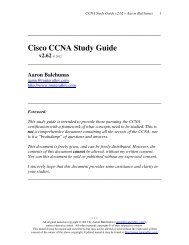OSI Reference Model - Router Alley
OSI Reference Model - Router Alley
OSI Reference Model - Router Alley
Create successful ePaper yourself
Turn your PDF publications into a flip-book with our unique Google optimized e-Paper software.
<strong>OSI</strong> <strong>Reference</strong> <strong>Model</strong> v1.31 – Aaron Balchunas<br />
6<br />
<strong>OSI</strong> <strong>Model</strong> - The Network Layer<br />
The Network layer (Layer-3) controls internetwork communication, and<br />
has two key responsibilities:<br />
• Logical addressing – provides a unique address that identifies both<br />
the host, and the network that host exists on.<br />
• Routing – determines the best path to a particular destination<br />
network, and then routes data accordingly.<br />
Two of the most common Network layer protocols are:<br />
• Internet Protocol (IP)<br />
• Novell’s Internetwork Packet Exchange (IPX).<br />
IPX is almost entirely deprecated. IP version 4 (IPv4) and IP version 6<br />
(IPv6) are covered in nauseating detail in other guides.<br />
<strong>OSI</strong> <strong>Model</strong> - The Data-Link Layer<br />
While the Network layer is concerned with transporting data between<br />
networks, the Data-Link layer (Layer-2) is responsible for transporting<br />
data within a network.<br />
The Data-Link layer consists of two sublayers:<br />
• Logical Link Control (LLC) sublayer<br />
• Media Access Control (MAC) sublayer<br />
The LLC sublayer serves as the intermediary between the physical link and<br />
all higher layer protocols. It ensures that protocols like IP can function<br />
regardless of what type of physical technology is being used.<br />
Additionally, the LLC sublayer can perform flow-control and errorchecking,<br />
though such functions are often provided by Transport layer<br />
protocols, such as TCP.<br />
The MAC sublayer controls access to the physical medium, serving as<br />
mediator if multiple devices are competing for the same physical link. Datalink<br />
layer technologies have various methods of accomplishing this -<br />
Ethernet uses Carrier Sense Multiple Access with Collision Detection<br />
(CSMA/CD), and Token Ring utilizes a token.<br />
Ethernet is covered in great detail in another guide.<br />
* * *<br />
All original material copyright © 2012 by Aaron Balchunas (aaron@routeralley.com),<br />
unless otherwise noted. All other material copyright © of their respective owners.<br />
This material may be copied and used freely, but may not be altered or sold without the expressed written<br />
consent of the owner of the above copyright. Updated material may be found at http://www.routeralley.com.

















